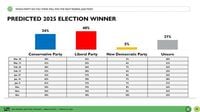In a significant shift in Canadian politics, the latest Abacus Data poll reveals that the Liberal Party has taken a narrow lead over the Conservative Party for the first time since 2022. The survey, conducted between March 20 and 25, 2025, indicates that if an election were held today, 38% of committed voters would choose the Liberals, compared to 37% for the Conservatives, and 11% for the New Democratic Party (NDP).
This poll marks a notable change in voter sentiment, as the Conservatives have dropped two points since last week, while the Liberals have gained two points. The NDP, meanwhile, has seen a decrease of one point. The results suggest a tightening race, particularly in key regions across Canada.
Regionally, the poll shows that the Conservatives and Liberals are statistically tied in British Columbia, while the Liberals lead by four points in Ontario, 12 points in Quebec, and nine points in Atlantic Canada. Conversely, the Conservatives maintain a lead in the Prairies, indicating that the political landscape remains diverse and complex.
One of the most striking findings from the poll is the shift in loyalty among past Conservative voters. About 12% of individuals who previously voted for the Conservative Party now express intent to vote Liberal, while 13% of former Liberal voters indicate they would switch to the Conservatives. The NDP faces a more significant challenge, as over half of its past voters are either undecided or planning to support another party, with 26% leaning towards the Liberals and 12% towards the Conservatives.
Among those voters who are most certain to participate in the upcoming election, the Liberal lead increases to three points, with 40% indicating support for the Liberals and 37% for the Conservatives. The NDP’s support drops to just 10% among this group, emphasizing the challenges it faces in mobilizing its base.
Approval ratings for the federal government have also seen a notable shift. Currently, 41% of Canadians approve of the performance of Prime Minister Mark Carney’s government, while 25% disapprove. This represents a significant change in public perception, suggesting that Carney’s leadership is resonating positively with voters.
Mark Carney, the leader of the Liberal Party, enjoys a net favorable impression of +11, indicating that many Canadians view him positively. In contrast, Conservative leader Pierre Poilievre has a net impression of -5, with 39% of Canadians expressing a positive view of him. The NDP leader, Jagmeet Singh, remains the least popular among the three main party leaders, with a net impression of -12.
Another factor influencing the political landscape is the perception of U.S. President Donald Trump. Only 12% of Canadians have a positive view of Trump, while a staggering 78% view him negatively, marking an all-time high for disapproval. Interestingly, among those who do hold a favorable view of Trump, 63% would vote Conservative, with an additional 8% considering the People’s Party.
The implications of these polling trends are significant. The Liberals have not only taken a lead in voter intention but are also more likely to mobilize their supporters at the ballot box, suggesting a potential enthusiasm advantage. This shift reflects a broader change in Canadian political dynamics, as many voters appear ready to move past the Trudeau era and embrace Carney’s vision for the future.
As the election approaches, the ability of each party to present a compelling vision will be crucial. Voters are increasingly focused on the challenges ahead, particularly in the context of global volatility and the impact of Trump’s presidency on Canadian politics. The leaders who can effectively communicate a forward-looking agenda and connect with voters on these issues are likely to gain the upper hand.
In summary, the latest Abacus Data poll highlights a pivotal moment in Canadian politics, with the Liberals taking a lead and voters showing signs of shifting allegiances. As the election nears, the focus will be on how these trends evolve and which party can best galvanize support among the electorate.





